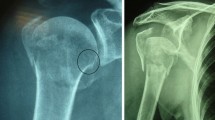Abstract
Gustilo type IIIb open fractures are most often associated with high energy trauma and cannot be closed by simple suture because of the high risk of infection and non-union. As an alternative to the external fixator, fixation by reamed locked intermedullary nailing was done according to the standard technique. The fixation allowed immediate partial or complete weightbearing and mobilisation of the neighbouring joints. In addition, it allows simple and rapid skin cover by flaps. This immediate skin cover allows one to diminish the risk of infection.
Résumé
Les fractures ouvertes de type Gustilo IIIb sont liées le plus souvent à des traumatismes à haute énergie et ne peuvent pas être couvertes par une suture simple. L’importance des risques d’infection et de pseudarthrose est élevée. En alternative au traitement par fixateur externe, une ostéosynthèse par enclouage centro-médullaire verrouillé avec alésage a été réalisée selon une technique classique. Le montage permet l’appui total ou partiel immédiat et la mobilisation des articulations voisines, de plus il permet la réalisation simple et rapide d’une couverture cutanée par lambeau. En effet cette réalisation immédiate permet de diminuer le risque infectieux.
Similar content being viewed by others
Bibliographie
Chapman MW (1986) The role of intramedullary fixation in open fractures. Clin Orthop Rel Res 212: 26–34
Court-Brown CM, McQueen MM, Quaba AA, Christie J (1991) Reaming intramedullary nailing. Its uses in type II et III open tibial fractures. J Bone Joint Surg [Br] 73-B: 959–964
Jenny G, Jenny JY (1991) Septic complications of intramedullary locked nailing in traumatologie in a series of 1 474 nails from 1974 to 1989. Orthop Traumatol 2: 51–54
Kempf I (1986) Enclouage centro-médullaire verrouillé des os longs. Cahiers d’enseignement de la SOFCOT. Conférence d’Enseignement, pp 221–227
Küntscher G (1962) Geschlossene Nagelung des frischen Unterschenkelbruches. Praxis der Marknagelung. Friedrich-Karl-Schattauer-Verlag, Stuttgart pp 111–116
Melcher G, Claudi B, Schlegel U, Perren SM, Printzen G, Munzinger J (1994) Solide versus slotted intramedullary nail in regard to susceptibility to local infection, an experimental study in rabbit. The combined 2nd International Traum Congress and 20th Anniversary of the locking nail, Strasbourg, p 108
Primavesi Ch, Hertz H, Kröpfl A (1994) Unreamed intramedullary nailing of tibial shaft fractures with soft tissue damage. The combined 2nd International Traum Congress and 20th Anniversary of the locking nail, Strasbourg, p 108
Ramadier JO, Lecestre P, Camilleri A, Bombart M, Mazas F, Witvoet J, Zucman J (1981) Fractures ouvertes de jambes. Int Orth 5: 169–182
Seidel H (1994) Management of open tibial fractures with reamed nailing. The combined 2nd International Traum Congress and 20th Anniversary of the locking nail, Strasbourg 108
Tornetta P, Bergman M, Watnik N, Berkowitz G, Steuer J (1193) Treatment of grade IIIb open tibial fractures. J Bone Joint Surg [Br] 75-B: 13–19
Vichard Ph, Tropet Y, Brientini JM (1989) Les fractures ouvertes de la jambe avec lésions cutanées majeures. Primauté de la couverture immédiate avec stabilisation interne du squelette. Chirurgie 115: 417–423
Weller S, Höntzsh D, Muller ME, Allgöwer M, Schneider R, Wileneger H (1992) Marknalung mit dem “unaufgebohrten” AO-Tibiastab. Manual der Osteosynthese, 3ème edn. Springer-Verlag, Berlin Heidelberg New York, pp 358–366
White AP, Russel TA, Lavelle DG (1992) Treatment of open fractures of the tibial shaft with the use of interlocking nailing without reaming. J Bone Joint Surg [Am] 74-A: 1162–1172
Author information
Authors and Affiliations
Additional information
S.O.T.EST, juin 1994 — Lons-le-Saunier
Rights and permissions
About this article
Cite this article
Schlemmer, B., Giraud, P. & Jenny, G. L’ostéosynthèse interne dans le traitement des fractures ouvertes Gustilo IIIb de la jambe. Eur J Orthop Surg Traumatol 6, 9–10 (1996). https://doi.org/10.1007/BF02718683
Received:
Accepted:
Issue Date:
DOI: https://doi.org/10.1007/BF02718683




